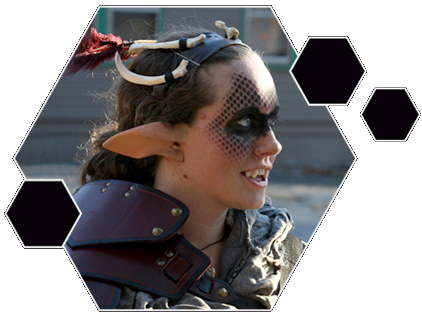MANEATER
Maneaters are polymorphic humans: shape-shifters with unstable physical forms who manifest various animal characteristics and mannerisms. They are driven by the pain of having a form which is constantly in flux, and their irresistible craving for human flesh, which eases that pain. They live primarily in the forests near human civilization, with some venturing into the world of man in search of greater understanding of themselves or, perhaps just a reliable food source.
MAKEUP AND COSTUMING
The external appearance of each Maneaters varies greatly, but their base genetic code is human, and their essential form must adhere to the standard for that species – they should not resemble an entirely different species. The animal characteristics they exhibit should be of mixed types and primarily mammalian, since these would be the easiest to shift into and maintain. (If you are looking to portray a non-mammalian-looking Maneater, please discuss your concept with us first).
Players are encouraged to use a combination of costume, prosthetics, and makeup, and to change these attributes over time to reflect their shifting, malleable nature. Maneaters living in the wild dress in natural colors and materials such as fur and leather, accented with bone and feather decorations, and trophies from their prey. Maneaters living in civilization might wear more ‘normal’ clothing.

HISTORY
Humanity’s first steps into the wider galaxy were not auspicious. There were too few ships and too many people; over-eager mankind had not yet realized all of the troubles it could encounter on long-distance interstellar journeys. Traveling from one inhospitable system to another for decades, their numbers dwindled, their ships fell into disrepair, and it seemed humanity was on the verge of extinction.
Then they encountered the friendly Ithgish, a species of mammalian shape-shifters, who were just coming out of a long period of seclusion. The Ithgish offered humanity a place to settle, the facilities needed to repair their ships, and food for their people. What followed were several decades of relative peace and tranquility, with the two species collaborating and flourishing.
During this time it was found humans and Ithgish could interbreed. This mingling sparked fears among the more conservative portions of the human population. The rhetoric spread: what had appeared as an act of goodwill was nothing but a ruse disguising the true desire of the Ithgish: the theft of human identity, human advancement, human excellence. The aliens were attempting to end humanity by breeding it out of existence. While this faction represented only a small, but vocal, subset of the human population, the group nonetheless managed to convince the Machine Mother (who was at that time much less advanced than she was during the Ascendancy) that the Ithgish were a threat that had to be dealt with.
The extinction of the Ithgish came after 20 years of fighting. As their final act, the last of the once-peaceful Ithgish released a genetic virus into the human population. This virus was designed to slowly, painfully, rewrite the DNA of humankind into Ithgish – with one notable change. These new Ithgish would be filled with a hunger for human flesh that could never entirely be sated.
This would have meant the end for humanity had the Machine Mother not intervened. While she could not eliminate the virus, she could prevent its effects and limit its transmission. She released nano-machines into the human population to halt the virus’ progression. As a second layer of defense, she programmed a directive called “The Countermeasure” which would be initiated if the virus ever overcame the nano-machines.
The Celestial Ascendancy formed shortly after the extinction of the Ithgish. Humanity carried the virus without incident until The Fall. When the Machine Mother left, the protective nanomachines became inert. Fortunately, after hundreds of years of dilution, the virus only effected a small portion of the population. The first Maneaters began to appear: sub-sapient, rarely able to speak, driven by the pain of their unpredictable shifts and hunger for human flesh.
In later generations, as the virus became more and more attuned to its original purpose, a species that looked a great deal like the Ithgish began to appear and The Countermeasure was activated. Within the span of 200 years, Countermeasure machines managed to wipe out most of the Maneater population within the galaxy, quarantining or eliminating any remaining human bloodlines they determined likely to carry the virus. Just as they were close to completing this task, they received a recall order that appeared to come from the Machine Mother.
Now the remaining Maneaters, the legacy of the Ithgish, have emerged from hiding and have begun appearing across the galaxy. As time passes, they come more and more to resemble their extinct creators, and are slowly continuing their push for greater legitimacy.
PLAYING A MANEATER
You are creature that is more beast than man, a monster. You have a constant craving for human flesh that you struggle to control, the more you suppress it, the stronger the craving becomes and the less control over your constantly-shifting form you have. There are times when you let your hunger go too long suppressed, and you must give in to it or go mad in hunger and pain. The only way you know to satisfy it is to feed. Once you have fed, the craving subsides and you are able to regain your control and self-awareness.
Maneaters range in intelligence from barely sapient to highly intelligent, depending on how the virus manifested within them. If you were raised in civilization, with a reliable source of fresh human flesh, you would be able to maintain your form and self control – as long as your circumstances did not change. A change in environment is generally accompanied by discomfort and unrest, physical shifts and changes as your body attempts to adjust to the new surroundings. If you have been living in the wild or with other Maneaters, with situations and meat supplies less predictable, you might seem quite feral, potentially never knowing a state of calm, physical stability, and clarity of mind.
You have a strong affinity for nature. You may choose to hunt alone or in a pack, either way, you desire the company of your own kind, with whom you forge tight bonds. You are unshakably loyal to your companions, both Maneater and other (once they have proven trustworthy).
A note regarding Maneater genetics: As mentioned above, the base genetic coding of a Maneater is human. Their morphic nature is not significant enough to change their species. A Maneater could attempt to imitate and live within a pack of wolves – the result would be a form that still appears more human than wolf, and includes traces of other creatures. Maneaters produce offspring in the same manner as humans (a Maneater child is often human in appearance at birth), and only with species that humans are cross-fertile with.
MANEATER TYPES AND SKILL PATHS
Maneater Skill paths are based around the method they use to find their prey. Scavengers hunt by instilling fear, and causing exhaustion. Stalkers overpower their foes with strength and fury. Lurkers stalk the shadows, waiting for the right moment to strike.
Others may purchase Dirty Tricks at no cost.
Maneaters begin the game with +5 Body.
Long Claws – 8 Build – Permanent Special – You may use “Long Claw” phys reps for any Skill that requires a specific Melee Weapon. These claws can be up to the maximum length for one handed weapons and should each be designed to look like a single long claw. Long Claws count as their own Weapon Type. They are a single Rank 3 Weapon called “Long Claws”, and can accept any Melee Weapon Upgrade. Any Attack that would Destroy or Obliterate your Weapon also effects “Long Claws” in the exact same way, and you would lose Upgrades accordingly.
Living Feast – 3 Build – Permanent Special – Spend 1 minute roleplay eating a Target in any stage of their Death Count. Target dies. You regain 5 Body.
Favored Enemy Human (Name) – 5 Build – Permanent Proficiency – At purchase you must name a specific Human Race. You do +1 Weapon Damage against that Race. Additional purchases allow you to name another Human Race. This Skill is not separate from the normal Favored Enemy Skill (see Xeno Hunter), and for Build purposes, a purchase of that Skill is equal to purchasing this Skill.
Not Food – 2 Build – Periodic Special – Allows you to mark a Human Target with your blood such that they will not be seen as food to other Maneaters for the remainder of the Period. As long as the Target does not initiate Combat with or in any way instigate a Maneater, a Maneater cannot initiate Combat with the Target. This is considered a mental Attack for the purposes of overcoming protection. A Maneater will not give this protection to a Human on a whim, for, if the human transgresses against other Maneaters while protected the Maneater who gave him the mark will likely find his life as forfeit. This is considered as a lesser form of the Blood Marking.
Collect Trophy – 4 Build – Permanent Special – Spend 1 Minute roleplay over a Dead Target. You Regain 1 Stamina. This can only be Once Per Target.
Hiss – 5 Build – Recurrent Voice/Mental Attack – Can only be used while you are doing something to a Downed, Out, Critical or Dead Target, or you are Concentrating. You may use “Hiss” on any Target that approaches you. Target is Afraid. You may spend 1 Stamina to reset the cooldown of this Skill.
Eat Tongue – 3 Build – Periodic Melee Attack – Can only be used on a Downed, Out, Critical, Dead, or Stunned Target. Tag Target. Target’s Tongue is Destroyed. Target is Mute. You regain 5 Body.
Leap – 4 Build – Periodic Special – Traverse. You may ignore any obstacles between you and the end of your Traverse.
Freakish Strength – 13 Build – Permanent Special – You gain the Athletics X Skill (see the Universal Skills List) with the Subtype “Strength” replaced with “Freakish Strength“: in addition to the benefits gained via “Strength” you also do a Permanent +1 Melee Weapon Damage.
Tackle – 2 Build – Periodic Melee Attack – Tag Target. Both you and the Target are Prone.
Brutal Strike – 3 Build – Periodic Melee Attack – Tag Prone or Stunned Target. Target takes Weapon Damage x3.
Bite – 3 Build – Periodic Melee Attack – Tag Target. Target takes +5 Weapon Damage. You regain 5 Body.
Feign Death – 2 Build – Periodic Special – Allows you to lay Prone and appear as if Dead. Any attempt to Diagnose you only reveals that you are Dead. While utilizing Feign Death you are considered to be in a Surprise State.
Howl – 2 Build – Periodic Voice/Mental Attack – Howl at visible Target. Target is Panicked. You may choose multiple Targets with this Skill, spending 1 Stamina for each additional Target. This Skill does not break Hidden.
Hemorrhage – 3 Build – Periodic Attack – Tag Target. Target takes +5 Bleed. Target cannot Hide from you for 5 Minutes after this Skill has been enacted.
Natural Camouflage – 6 Build – Recurrent Special – You may become Hidden by pressing your back against any immobile vertical surface that is larger than you are and spending 2 Stamina. You may also spend 2 Stamina to use the Periodic Skill “Hide”.
